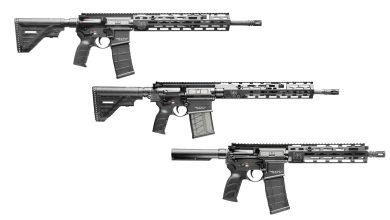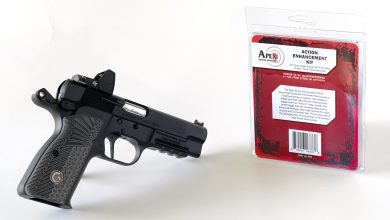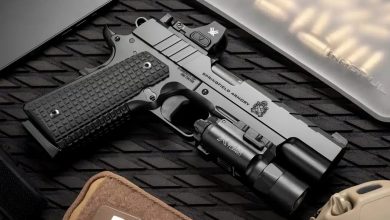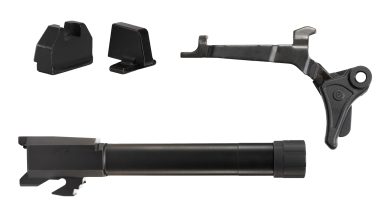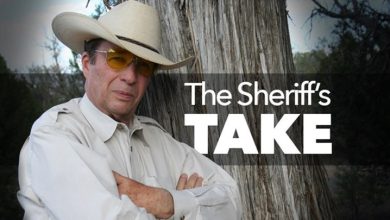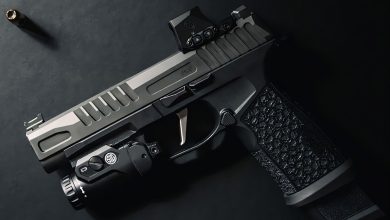Straight Talk: Jelly Bryce Oklahoma Shootist
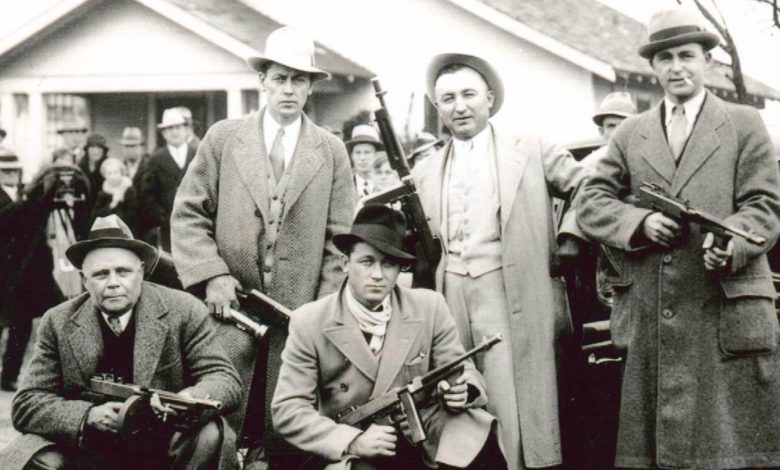
From the time he started his law enforcement career in the late 1920s until his retirement from the FBI in January of 1958, D. A. “Jelly” Bryce (kneeling, right) would develop a reputation as a first-rate marksman, an exhibition shooter—with a formidable fast draw—and an impeccable dresser.
One of the more interesting gunfighters to come out of the Southwest in the years before World War II was an Oklahoman named D.A. “Jelly” Bryce. Born in 1906, Bryce became interested in guns and hunting at an early age, and naturally seemed to gravitate to a career in law enforcement. In 1927, he was serving as a state game warden and participating on that agency’s pistol team. Primarily due to his shooting skills, he was recruited to the Oklahoma City Police Department the very next year. Interestingly, he was assigned directly into the detective division and became a member of the department’s auto-theft squad.
As the “Great Depression” began to take effect, stolen cars were big business. There was a market for cheap vehicles, and the growing gangs of armed robbers continually needed to acquire stolen cars that they could use for getaway vehicles. Bryce, the young detective, was quickly thrown into the middle of dealing with these offenses. He and his partners were involved in several shootouts, often resulting in the death of the outlaws. It was probably one of these captured outlaws, who nicknamed him “Jelly.”
Bryce supposedly encountered one thug who was in the process of hot-wiring a car. When the thug pulled a gun, he shot him in the shoulder and drug him out of the vehicle. Looking at Bryce, who was always neatly and sharply dressed, the crook exclaimed, “I can’t believe I was arrested by a Jelly Bean!” In those days, “Jelly Bean” was a term used to describe people who dressed sharply. For the rest of his life, Bryce was stuck with the nickname “Jelly” and, by all accounts, took pride in it and tried to live up to it.
Jelly Bryce soon developed a reputation of not only being a good, quick pistol shot, but also not being the least bit reluctant to engage in gunfights. He was reluctant, however, to discuss those gunfights with the general public. As a result, while there are all sorts of tales about shootouts in which he was involved, most of them are quite difficult to document. Later in his life, however, Bryce told a friend that he had been involved in 19 gunfights. Two of them are particularly worth noting.
In 1933, armed robber and killer Wilbur Underhill escaped from yet another prison. Oklahoma lawmen traced him to a residence in the town of Shawnee. The local FBI boss recruited a group of lawmen, among them Bryce, to affect the apprehension. In the shootout that followed, Underhill received fatal wounds and soon expired. Photos taken of the posse of lawmen show Bryce spiffily dressed as usual and armed with a Thompson submachine gun.
In 1934, Bryce led a small group of his fellow detectives into an Oklahoma City hotel looking for some thugs known to associate with Clyde Barrow. Forcing his way into a hotel room, Bryce saw gang member Ray O’Donnell lying on a bed and pointing a .45 ACP at Bryce. Dropping into his signature crouch, Bryce palmed a revolver and shot O’Donnell five times, killing him before the thug could fire.
The revolver Bryce carried then was a Smith & Wesson Third Model .44 Hand Ejector. This was easily recognized by the shroud under the barrel that protected the ejector rod. His particular .44 had a 4-inch barrel, fixed sights, nickel finish and was engraved by Wolf and Klar of Fort Worth, TX, with ornately carved ivory stocks. (It appears that Jelly Bryce liked fancy guns to go with his fancy clothes.)
In 1934, Bryce was one of several Oklahoma City police officers who were recruited into what was then the Bureau of Investigation. J. Edgar Hoover had an organization full of young lawyers and accountants who didn’t have a clue how to chase down and arrest the likes of John Dillinger, Charles Arthur “Pretty Boy” Floyd and Lester Joseph Gillis (a.k.a. George “Baby Face” Nelson). So, he quietly ignored the requirement for college degrees and recruited some gunfighters. Bryce and his fellow shootists did their job.
In his later years Bryce taught firearm techniques to new agents and represented the bureau by putting on shooting exhibitions. He was known for his point-shooting techniques and for using a deep crouch when drawing his gun and getting his shots off. Point shooting and the deep crouch became FBI trademarks for that era.
Shooters like Bill Jordan and Dan Combs showed that crouching during the draw was unnecessary and wasted time. Still, it was a fancy technique for a lawman who was just a bit fancy himself. Bryce spent a lifetime going up against some of America’s more desperate criminals and he did it with style.
Read the full article here


